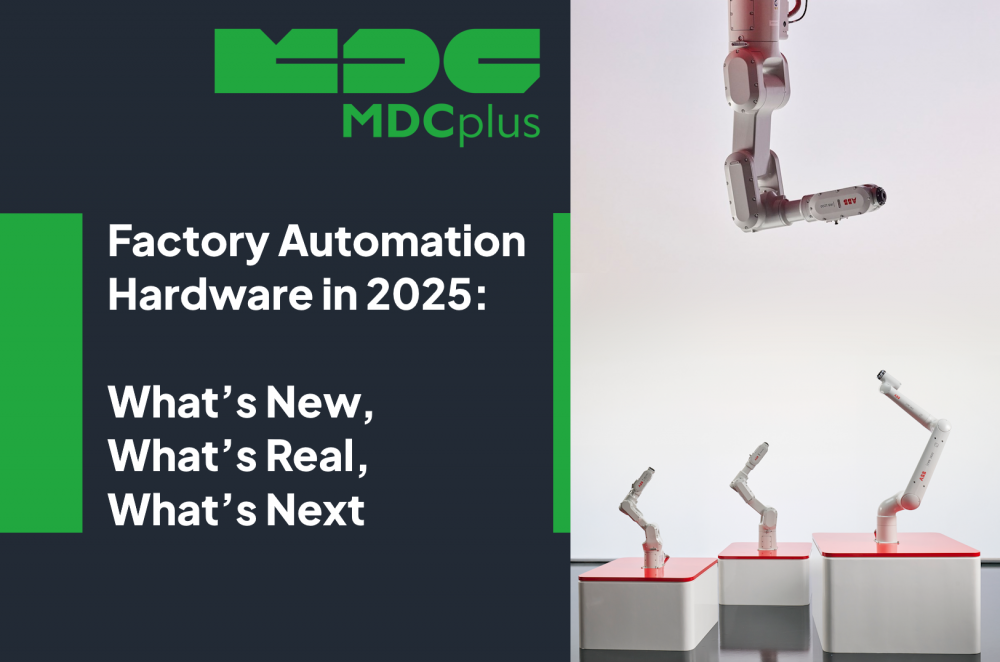Factory Automation Hardware in 2025: What’s New, What’s Real, and What’s Coming Next
The newest generation of automation hardware reflects the new shift, moving away from fixed, bulky systems toward modular, AI-enhanced, and sensor-driven tools that bring smart decision-making to the edge of production. Here's a clear look at what’s changed — and what it means for manufacturers ready to modernize.
Smarter Robots, Faster Deployment
One of the most visible transformations is happening with robotics. Traditional industrial arms are being replaced or supplemented by lighter, smarter units. ABB’s latest lineup – Lite+, PoWa, and the IRB1200 series – is engineered for fast deployment, mid-volume production, and minimal programming overhead. These systems can be trained by demonstration and become operational within an hour.
Collaborative robots (cobots) are also gaining ground. With built-in force sensors and AI coordination, they operate safely next to humans, eliminating the need for fencing or dedicated zones. For small and mid-sized manufacturers, this means automation is no longer gated behind six-figure integration projects.
Humanoid Robots: From Concept to Pilot
Humanoid robots – once a curiosity of lab research – are beginning to appear in commercial deployments. Agility Robotics’ Digit, Tesla’s Optimus, and Boston Dynamics’ Atlas are being piloted in warehouses and production facilities.
These machines aren’t replacing skilled labor. Instead, they handle repetitive or ergonomically difficult tasks: transporting bins, feeding machines, or operating simple controls in environments too variable for traditional robots. Their advantage lies in form factor – they can adapt to spaces built for humans, rather than requiring factories to be rebuilt for automation.
Edge Intelligence, 5G, and Sensor Fusion
In 2025, factory automation hardware is only as powerful as the data it can process. That’s where edge computing and sensor fusion come in.
New generations of machine controllers and PLCs are embedding AI directly on the shop floor. Combined with 5G connectivity, this allows machines to communicate instantly – enabling everything from real-time quality control to predictive maintenance.
Multimodal sensing is also advancing. Tactile sensors, thermal imaging, 3D vision, and vibration analysis can now be deployed affordably and in compact formats. The result: machines that don’t just operate – they observe, learn, and react.
Modular, Plug-and-Produce Cells
Automation no longer needs to be custom-built for each plant. “Plug-and-produce” systems – standardized robotic palletizers, inspection stations, and conveyor cells – are becoming mainstream. Entire automation modules can be installed and commissioned in days instead of weeks.
This modularity is critical in a market where product lines change fast, labor is scarce, and downtime is expensive. Flexible cells can be redeployed or reprogrammed as needed, keeping capital equipment in use longer and justifying automation at lower volumes.
High-Speed Motion and Magnetic Conveyors
Precision motion systems are evolving too. High-resolution servos and synchronous controllers enable ultra-fine assembly tasks and synchronized multi-robot operations. Meanwhile, research into magnetic levitation conveyors is opening up new possibilities for clean, frictionless, high-speed material handling – particularly in electronics, pharmaceuticals, and advanced packaging.
These technologies support a larger trend: minimizing mechanical wear and maximizing control fidelity, especially in continuous operations where even minor friction becomes a source of cost and downtime.
Strategic Implications for Manufacturers
For manufacturers, the message is clear: automation hardware is no longer one-size-fits-all. It’s flexible, scalable, and increasingly intelligent.
To stay competitive in 2025 and beyond, plant leaders should:
-
Assess modular deployments that scale with product demand
-
Explore cobot and humanoid pilot programs in high-labor areas
-
Invest in sensor-rich environments for quality and uptime
-
Bring AI and monitoring to the edge, not just the cloud
-
Think reconfigurable, not fixed
Final Thought
The automation revolution isn’t coming – it’s already underway. What’s different in 2025 is the accessibility. Smart robots, real-time sensors, and modular automation platforms are no longer reserved for Tier 1 OEMs. They’re available, deployable, and designed for fast ROI.
Manufacturers who act now can build systems that scale with their business – not just with their headcount.
About MDCplus
Our key features are real-time machine monitoring for swift issue resolution, power consumption tracking to promote sustainability, computerized maintenance management to reduce downtime, and vibration diagnostics for predictive maintenance. MDCplus's solutions are tailored for diverse industries, including aerospace, automotive, precision machining, and heavy industry. By delivering actionable insights and fostering seamless integration, we empower manufacturers to boost Overall Equipment Effectiveness (OEE), reduce operational costs, and achieve sustainable growth along with future planning.
Ready to increase your OEE, get clearer vision of your shop floor, and predict sustainably?
